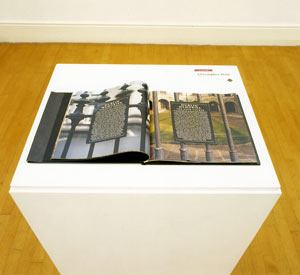2000-2002: Dublin Memories - Hugh Lane Gallery
Introduction: A writing practice expands
This project originated from my writing practice. Towards the end of the 1990’s I was writing monologues both using my experiences and also using the experiences of others. Writing using one’s own experiences is not as straight forward as it may first seem. My experiences may consist of things I do and things that happen to me, my own experiences can also include stories I heard or imagined or dreamed. However on one occasion I was writing from the point of view of a blind man. During the process of trying to write about this character’s life I realised that though imagination and empathy are important I was limited through my lack of experience and I felt I should actually talk with someone who has experienced blindness. I was given the opportunity to do this through the National league of the Blind and through this meeting I made a video artwork in collaboration with Eddie Hughes called ‘Eddies Walk’. This was exhibited in Temple bar galleries, Arthouse and Westboune Studios (London) that year. I felt this approach opened my art and writing practice from being a closed, solitary practice into an open social practice. I also felt this approach placed the inner individual voice into the gallery and placed value on it.
A Collaborative Practice evolves
One of the reasons I got interested in and began to write was my interest in the inner voice and its potential truth-telling power. Growing up in an Irish context in the 1960’s, 1970’s and 1980’s I was intensely aware that so much was unspoken and so much of my human experience and other peoples went unshared. Instead large swathes of my experiences as I grew into my adulthood were swathed in what I would later call toxic shame. However in 2000 when I began Dublin Memories I had no name for it – I just knew there was so much of human experience that was hidden and had feelings such as embarrassment attached. I felt I was ready to begin to share more of my experiences, to start to come out as a human being and I felt I wanted to meet other people who were also comfortable with sharing. I began doing this through picking up the yellow pages and contacting supportive organisations as well as friends and acquaintances. I began making recordings soon after and by the end of 2001. I spoke to forty people including a self-recording. In each case I gave people a hand out with information on my intentions and the process involved. As with Eddies walk I felt that an artwork would emerge from this collaboration. This work would respect the real lives and experiences of real people who are often are overlooked or hidden away. I first began distributing samples of work from this collaboration in 2001. In 2002 I exhibited the final work in the Hugh Lane Gallery as part of the end of year Masters of Fine Art Exhibition.
Chris Reid August 2014
The text below is an unedited transcription from the Masters of Fine Art exhibition at the Hugh Land Gallery in June 2002. The text briefly outlines the process of making Dublin Memories.
I constructed a framework that enabled people to speak confidentially of their experiences living in Dublin. This social aspect was the research from which the work evolved. To avoid clichés and stereotypes I interviewed across class, race, religion, nationality, gender, sexuality – what all the participants had in common is that they live in Dublin. I recorded oral narratives that often articulated memories that many people would be embarrassed, or unwilling to articulate in public and that would ordinarily be repressed. From edited transcripts I constructed a narrative that maps experiences of displacement on to the city. This narrative is made of multiple voices none of which exercises authority over the others. It is told through the first person singular and it is made up from diverse, disembodied, nameless voices that speak about personal experiences of displacement, marginalisation, anxiety and alienation. Together they constitute a bricolage made from shards that have no closure, no completeness and no coherent or whole identity. Each memory was given the authoritative typographic form of a heritage plaque and placed back – to narrate and dispute with – the specific place where it originated. Both place and plaque were then carefully photographed. Each plaque can be seen to conflict with prescribed perceptions of the place and those power relations embedded within its spatial and architectural matrix. Each contributes to a larger narrative that anxiously hovers between being nether self nor other, between narrative and experience, between being authoritative yet hysterical, between being public yet uncomfortably private, included yet excluded, in place yet displaced, between dispersing and cohering into a representation of Dublin through living memory.
The installation consists of a series of large scale photographs and an artist’s book which are installed in the gallery. The photographs in the artist’s book refer to a series of thirty site specific pieces which will be hung on railings around the city during the exhibition.
Chris Reid June 2002


